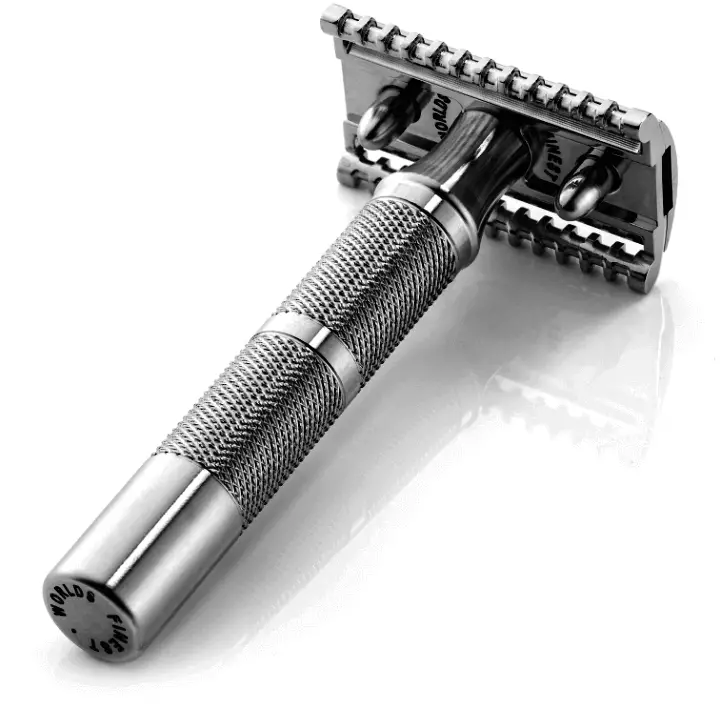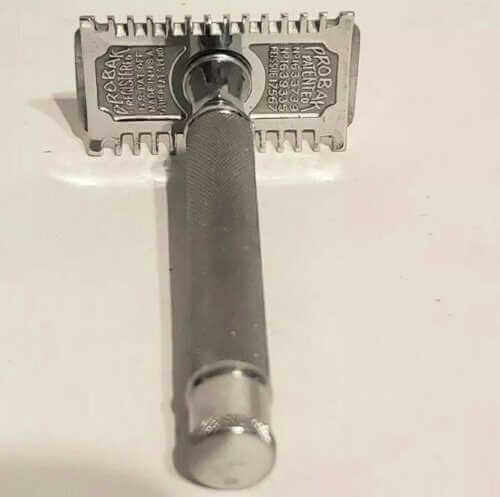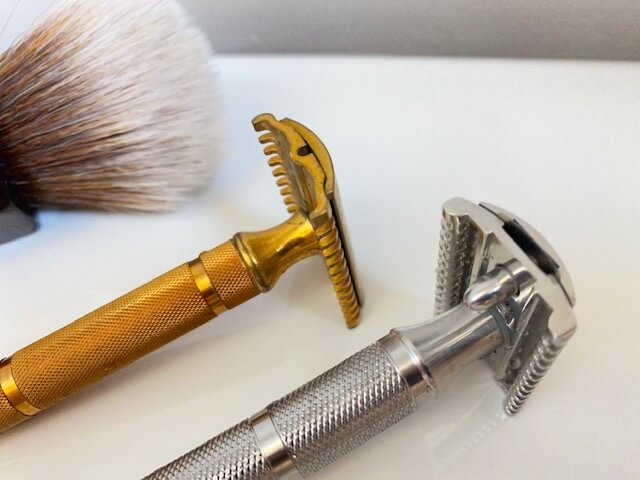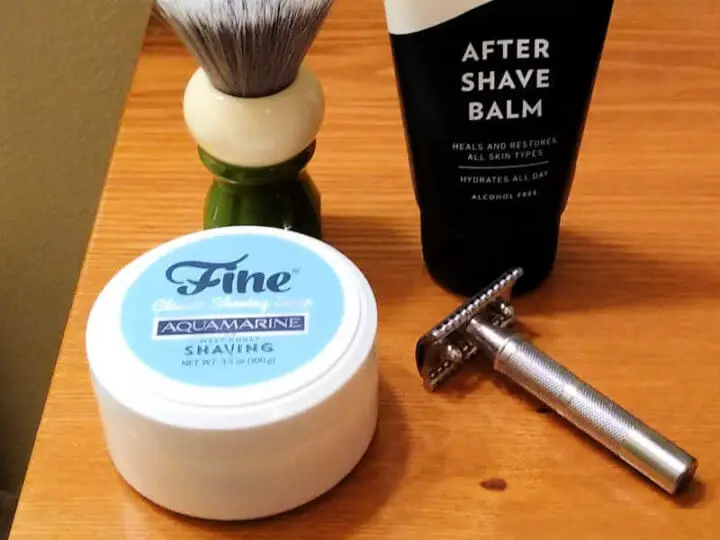[Note from Mantic59: Victor Marks and I received a razor from Fine at no cost but under no obligation. This article was not reviewed or approved by Fine. The bulk of this article was written by Victor, with added comments from me where noted.] Fine Accoutrements is a maker of superb soaps, excellent soap bowls, and even travel cases for your 3 piece razors. They’ve made a small number of razors in the past. But have they made the World’s Finest Razor?
What it is
The Fine Accoutrements World’s Finest Razor is a 3 piece stainless steel razor. It has the unique property of a guard bar that looks and feels like an open comb razor. When you pull it through lather on your face, it leaves trails just like a comb guard.
It’s not based on just any open comb razor; Fine told us that it takes inspiration from the Gillette NEW long comb. For Fine Accoutrements, the NEW was their favorite razor of all time (and what they believe to be the high point of Gillette quality).
With that in mind, and the knowledge that Gillette isn’t making razors from 1929 anymore, Fine set out to pay homage to it. I would summarize it by borrowing the words of the poet laureate of our time, Tenacious D, to say, “This is not The Greatest Razor in the World, no. This is just a tribute.”
But what a fine tribute it is.
How We Got Here
We need to go back to 1926. Gillette purchased razor-maker Roth-Buchner in 1926. Over time, it became a high performing subsidiary, producing blades and razors in Germany. In 1928, Gillette acquired Otto Roth, a Roth-Buchner subsidiary based in Newark, NJ. Gillette used the Otto Roth name in the U.S. in the 1930’s.
Henry J Gaisman was the founder behind Autostrop Razor Company. In 1927, he was granted a patent on his Probak razor, which included patents on a large number of blade mounting methods. The strange shape in the center of a blade that accommodates pins and a central rail to locate a blade? It also can accept diamonds and T shapes at the ends of the blade. Our modern blade came about as a result of trying to work with all of the patterns that Gaisman patented.
Gillette was the largest razor company at the time, and began to make blades that infringed on Gaisman’s patent. Gaisman protested, and after an extended time, a settlement was reached.
Gillette settled the case by buying Gaisman’s Auto-Strop company for 310,000 non-voting shares. This was to be the undoing of King Camp Gillette: A due-diligence audit of Gillette by Auto-Strop found that Gillette had been overstating sales, inflating earnings by $12 Million USD over 5 years. Before closing on the 310,000 non-voting shares, Gaisman demanded preferred stock with voting rights. This gave him control of the company. Gillette was out. Gaisman was in. Gaisman brought along executives from Auto-Strop, executing a reverse take-over.
Gaisman’s Gillette used the Probak design to make the Gillette NEW razor in Long, Short, and Deluxe forms. Some of the NEW-style long comb razors were branded as Otto Roth razors to pick up customers of the “non-Gillette” market. That ended in 1939 when WWII started, and German brand names became unfashionable. You can find Gillette open comb razors with the Otto Roth name xxx’d out. Gillette just used the same production facility to produce NEW razors branded Gillette instead of Otto Roth.
How We Got Here, Part.2
Back in the future, 94 years later, Fine Accoutrements has made three razors previous to this one. The Fine Superlite was an ABS plastic attempt to replicate the feel of the Bakelite slant razor. The Fine Slant refined this and re-implemented it in aluminum. The Fine Marvel attempted to make an affordable razor for new-comers to safety razor shaving.
The World’s Finest Razor has a guard bar with fins that make it feel like the open comb guard, and the baseplate is printed with lines and the words “World’s Finest” in a pattern similar to the Probak’s ‘tombstone’ markings.
What Does The Manufacturer Say?
From the Fine Accoutrements Website:
“…Smartly utilizing a combination of meticulous design, ultra-premium material, off-shore manufacturing, and an exclusive direct-to-consumer sales model, The Worlds Finest Safety Razor offers wet-shavers impeccable quality at impossible to beat pricing.
“…Explicitly designed to leverage the legendary sharpness of Feather Double Edge Blades, you can expect incredible shaving comfort and baby-butt smooth results every time.
“Further, with each piece precision machined from solid 316 Marine Grade Stainless Steel, The Worlds Finest Safety Razor also provides the ultimate in durability. Unlike typical safety razors (modern or vintage), it will never break, bend, or chip – and the finish is forever restorable to its original luster. Even other “premium” razors – constructed of softer steel (usually 303 or 304) – will often develop mild rust (a.k.a. tea stains) wherever the blades make direct contact with the razor itself. 316 Stainless is more costly but avoids this issue too.
“Finally, the benefits of the gleaming polished finish featured on The Worlds Finest Safety Razor go beyond the mere cosmetic. This costly and labor-intensive procedure requires multiple mechanical passes over each part with increasingly fine abrasives. But the results are well worth the price, as users can expect improved glide during use, easier cleaning, and superior long-term corrosion resistance.
“Made domestically and sold traditionally, this razor would undoubtedly carry a $500 price tag. Mr. Fine offers The Worlds Finest Safety Razor here, exclusively, for just $165.
“Fine Travel Case & 5 Feather DE Blades included with purchase.
Length 3.35 in. / 85 mm
Weight 3.39 oz. / 96 g
Unique Low-Profile/Sure-Grip Knurling
Minimalist Industrial Packaging
Made in China”
These razors did deliver good shaves, but were very sensitive to blade choice, and took a careful, practiced hand. How does the new World’s Finest Razor differ? And what is the world’s “finest” shave, anyway?
How’s It Shave (Victor & Mark)?
[Ed. note, Amazon links are affiliate.]
Victor:
To begin, I needed to get a baseline. I used a Gillette NEW long comb with a Derby Extra blade. I did this because the Derby worked very well in the Fine Superlite and Slant. I planned on shaving on one side of my face with the NEW, and on the other side with the newer World’s Finest Razor.
Friends, it was not kind. It was a shave full of nicks that was generally unpleasant, and irritable in specific. With expectations set, I loaded the same blade into the World’s Finest Razor (which I will call WFR after this, because it’s just getting to be a lot to type.) The WFR felt very similarly, also with slightly fewer nicks. What was very interesting was, the WFR’s guard bar left the same tracks in the lather as the open comb of the NEW.
Same feel. Same pattern in the lather. I felt like we were on to something here. I tried a blade I don’t use very often, the Wilkinson Sword in the black blade bank. To my complete surprise, the nicks disappeared, blade feel went away, and the WFR became a razor I can tell you about without hesitation.
But I wasn’t done. I put the Wilkinson in the old Gillette. The shave here had a few weepers, but was otherwise much improved from past experiences with it. And that would have been enough. I could have put down the Gillette, picked up the WFR, and shaved with it for years to come, almost effortlessly.
The thing of it is, Fine recommends Feather blades. There’s nothing wrong with Feather; they’re wonderful in many razors. I include them in every blade sampler I make up when I give a new safety-razor user a starter kit.
But they didn’t work well for me in the WFR. I returned to the nicks and discomfort I had felt initially. The conclusion was clear and stark: return to the blade that was comfortable.
I shared my experiences with Mark, who runs the site you’re reading, and he confided that the razor also shows the difference that angle makes – for him, tending to ride the guard rather than the guard and cap, or riding the cap:
Mark:
I find the fit-and-finish of the razor excellent and the look of the razor quite attractive (though personally I would prefer the textured knurling to extend to the bottom of the handle). The “gleaming polish finish” certainly is gleaming and really “pops” in the right light.
The comb design is interesting: it looks like a combination of the common scalloped base plate and an open comb. To me it looks like a kinder, gentler version (thank goodness!) of the Muhle R41 comb.
Like Victor, I decided not to tempt fate with my first shave with Fine Accoutrements razor: I used a Derby blade instead of the recommended Feather blade. But I think the Derby turned out to be a mistake–the shave felt harsh with a DFS-with-a-few-“weepers” result.
For the next few shaves I used a Parker blade (my go-to). And they were pretty solid shaves! Near-BBS with a few small weepers.
When I had some understanding of how the razor performs I decided to throw caution to the wind and try a Feather blade.
And I immediately understood why Fine Accoutrements recommends a Feather blade for this razor My first shave with a Feather blade was noticeably closer and more comfortable than my shaves with other blades: BBS with a couple small “weepers” (I anticipated the weepers–Feather DE blades always do that to me on their first shave).
It’s clear to me that this razor shows the differences in blade characteristics more readily than most other razors I’ve tried.
It also shows the differences in blade angle more than other razors I’ve used. Doing things like “riding the comb,” “riding the cap,” and shaving with a normal angle result in different performance characteristics for me.
What Is The World’s Finest Shave?
The world’s finest shave is not the one that is the most smooth. It is not the one that you would medal in, if shaving were an Olympic sport.
The world’s finest shave is the one that is comfortable, gives repeatedly smooth results, and does so with a minimum of effort. Can you repeat it day after day with consistent quality? There are lots of variables; lather, water, temperature, nerves, and all the different ways you can drag the razor stroke across your face. But if you have a good razor and good results, that’s the World’s Finest Shave.
In 1929, shaving wasn’t a hobby, it was a chore. Back then, you had a prized razor because they cost so much. $5 in 1929 is about $76 today. For that price, they were made of brass and plated with a thin layer of 22k gold.
The World’s Finest Razor is $165, made of marine grade stainless steel, and polished to a bright shine. We judge a shave on face value. And the question is, is the value here? Are you a NEW-holic? Do you think Gillette’s NEW is Über (GNU)? Are you in the Brotherhood of the Open Comb? If you like the Gillette NEW, and want a modern, improved version of it, this is your razor. And, it’s a Fine one.





I am definitely a fan of The New. I own three variants of this generation of Gillette razors and favor them in descending order as follows; De Luxe, Short Comb, Long Comb.
IMO, engineering a razor specifically for the Feather DE blade is a mistake, because it is renowned for performing roughly on the first shave, and smoothing out afterwards. If a razor blade is used for an average of 3 shaves, then this would result in a rough shave 1/3rd of the time. That is not what I expect of a top tier razor. And, that is why I do not use Feather blades, in addition to the exhorbitant cost of them.
IME, The New works a charm with blades that are inherently smooth and sharper than average, such as a Wizamet Super Iridium, Perma Sharps, or an Astra SP. These blades are highly predictable and consistent performers and much lower cost than Feather blades.
If one favors a heavy razor, then I suggest The New De Luxe with a Karve Christopher Bradley handle of the length of your choosing. I have a hard time believing that this Fine razor could outperform that weighty hybrid of vintage and new.
I would personally be more interested in a nickel plated CNC brass razor in the spirit of The New De Luxe but optimized for our modern thin and coated DE razor blades; with an emphasis on clamping close to the cutting edge in order to minimize chatter or flex. Blade flex was not a significant issue in 1929 because DE blades were thicker.
But, isn’t that essentially what the Karve Christopher Bradley razor attempts to do? And, they are manufactured in North America for far less than $500.00, in AL, Brass, 303 SS, and Copper.
Thank you for the review. To me, naming a razor “World’s Finest Razor” is a bold statement especially when wet-shaving has so many variables. If I had a dollar every time I have read, “your mileage may vary” in a review, I would be able to retire.
The shaving cream lather “tracks” mentioned in the article reminded me of another Sharpologist article about double-open comb razors, which look aggressive, but are actually mild shavers because the design allows for lather tracks which provide additional lubrication. One of my favorites is PAA’s Copper Ascension razor, and perhaps that is the World’s Finest Razor?
The problem is this:
There are some razors that are perfect for a smaller number of users.
There are some razors that are perfect for a wider number of users.
There are few that are perfect for everyone, but are probably pretty good for most people. I don’t want to say someth
How each writer here thinks of writing about them is different. I wouldn’t think the Ascension would be that mild, and while it leaves tracks, it’s more like the Mellon double open comb from 1944. What was notable here was that despite having a guard bar, the WFR leaves tracks exactly like the NEW. That’s less interesting from the Ascension, where it’s a comb and expected.
This is basically a refined Gillette NEW Long Comb. If you like the NEW, and many people do, it’s the best thing in the world for you.
If you don’t (and I understand if you don’t) then I’d tell you to look at other things.
Brother Victor,
I de-Fine the quotation you cite to read, “[If] the WFR were made domestically [in America] and told traditionally [at full retail], it would cost $500.”
Furthermore, elsewhere the article specifically says, “Made in China.”
Outstanding and informative read on the finest razor these fine folks have forged.
Congratulations on another interesting article, though it was almost too long to digest.
I believe the Gillette NEW, either the SC or LC version, is one of the better razors to own and to shave with. The 1930’s were precious years in the world of shaving, in spite of the Great Depression. I’m a confessed NEW-aholic with 3 of them, 2 of which have been beautifully re-plated, (one in rhodium and the other in 18k gold).
I enjoyed reading about the WFR and I wish it and its manufacturer well. But with respect to all, I personally would prefer to buy a sound antique Gillette NEW and then to have it re-plated in a favorite metal, than to spend similar money on the WFR. I understand the quality of the shaves would be comparable. The designs would be somewhat similar in appearance, especially in the handles.
There’s also an added benefit that all the dollars spent would stay here in America.
“Made domestically and sold traditionally” – all the dollars spent would stay in Amerca for Fine Accoutrement’s razor.
The WFR shaves better. I hope someday you get to experience it, it’s an improvement on the classic.
Comments are closed.